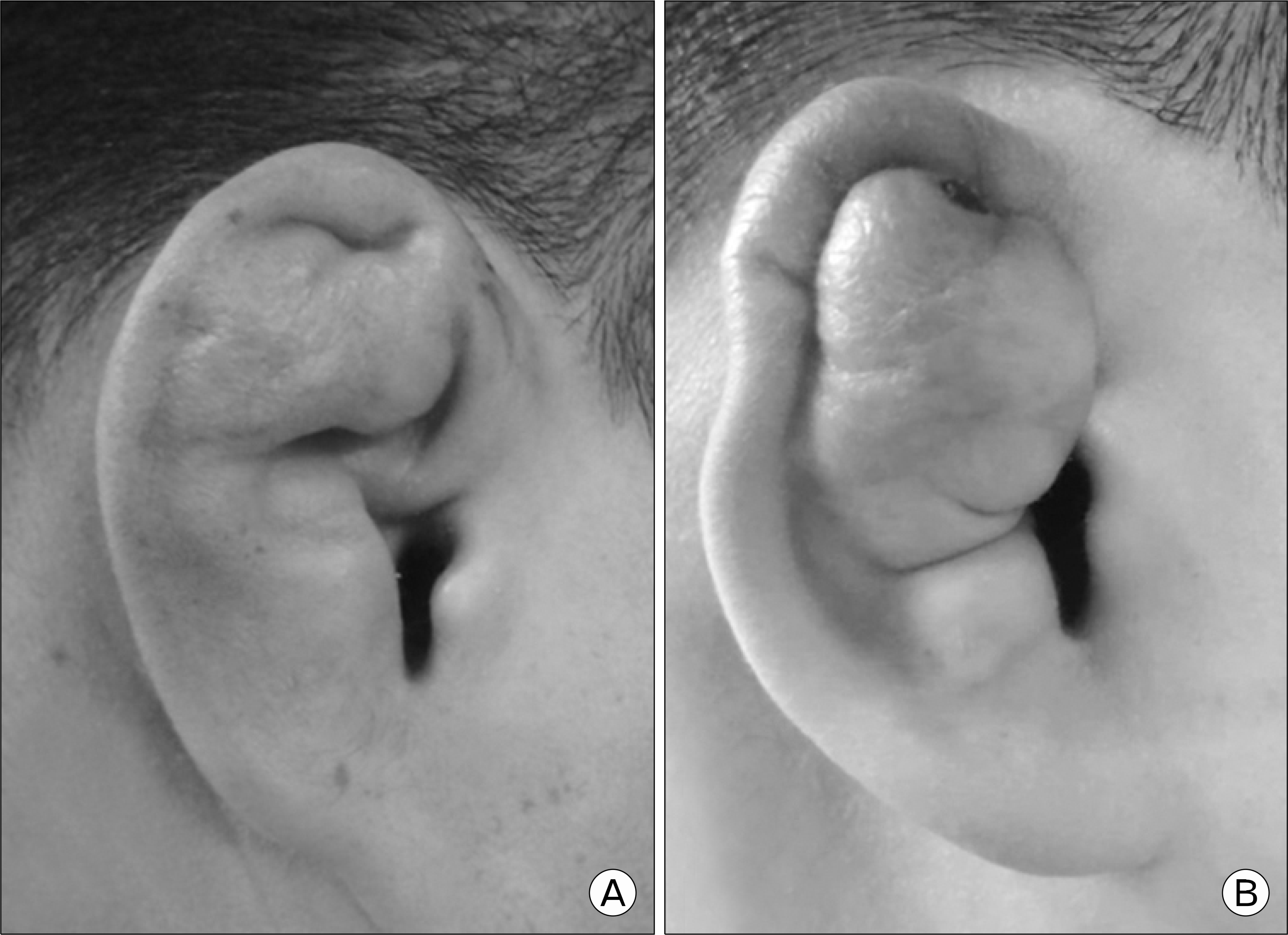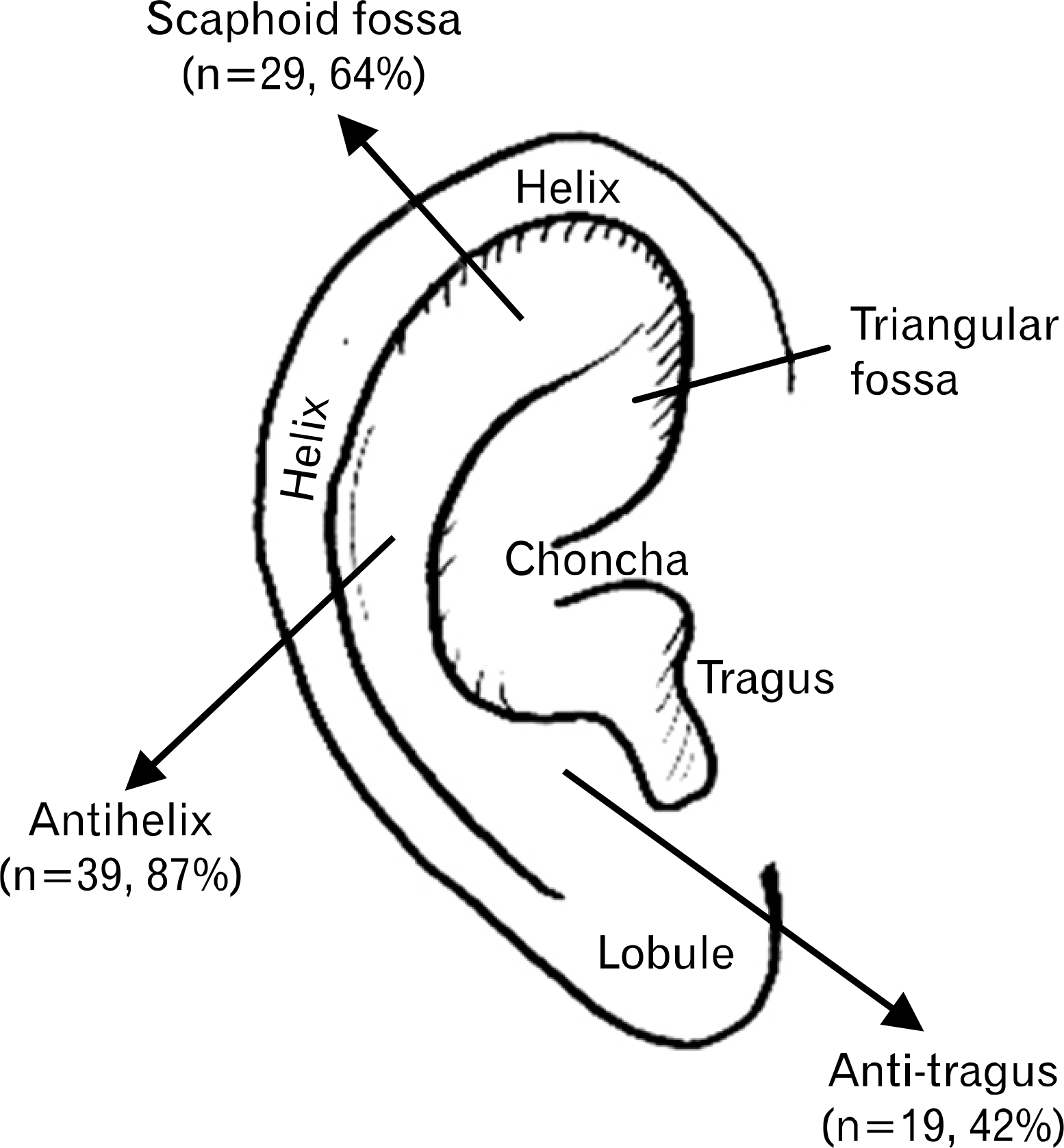Abstract
Wrestlers has frequently injured on his ear by friction or hitting. If the ear injury like hematoma did not treat appropriately, it should be deform to disfigured outer shape. We analyzed the incidence and characteristics of ear deformity with elite wrestlers. We took the photo with elite 58 male wrestlers’ ears. We surveyed the carrier of elite player, duration of training time, ear injury history, treatment history and satisfactory scale of his ear shape. The characteristics of ear shape were classified by Yotuyanagi classification. 44 wrestlers has deformity of his ear in elite wrestlers (76%, 44/58). Right side ear deformity is 50 cases, bilaterally involvement is one case. Microtia was 11 (24%), ear protrusion was 15 (33%) cases. Yotuyanagi type IB was 13 (29%) cases that deformity extending from helix to antihelix. Type IIA was 12 (27%) cases that deformity with a substantial change with good structural integrity in outline of the ear. Acute ear injury was treated with simple icing (33 cases, 56%), aspiration and compression (6 cases, 10%). 34 wrestlers (77%) dissatisfied his own ear shape. 10% of acute ear injuries treat appropriately in domestic elite male wrestlers. 76% of the wrestlers has an ear deformity and dissatisfaction.
REFERENCES
1.Mudry A., Pirsig W. Auricular hematoma and cauliflower deformation of the ear: from art to medicine. Otol Neurotol. 2009. 30:116–20.
2.Greywoode JD., Pribitkin EA., Krein H. Management of auricular hematoma and the cauliflower ear. Facial Plast Surg. 2010. 26:451–5.

3.Park C., Yoo YS., Hong ST. An update on auricular reconstruction: three major auricular malformations of microtia, prominent ear and cryptotia. Curr Opin Otolaryngol Head Neck Surg. 2010. 18:544–9.

4.Schuller DE., Dankle SK., Martin M., Strauss RH. Auricular injury and the use of headgear in wrestlers. Arch Otolaryngol Head Neck Surg. 1988. 115:714–7.

5.Yotsuyanagi T., Yamashita K., Urushidate S., Yokoi K., Sawada Y., Miyazaki S. Surgical correction of cauliflower ear. Br J Plast Surg. 2002. 55:380–6.

8.Jones SE., Mahendran S. Interventions for acute auricular haematoma. Cochrane Database Syst Rev. 2004. 2:CD004166.

9.Hwang K., Kim CW., Lee SI., Park IS., Kim WC., Loh JJ. Could ionizing radiation forestall cauliflower ear? Ann Plast Surg. 2001. 46:141–5.

10.Kordi R., Mansournai MA., Nourian RA., Wallace WA. Cauliflower Ear and Skin Infections among Wrestlers in Tehran. J Sports Sci Med. 2007. 6:39–44.
11.Stiernberg CM., Strunk CL. Ear injuries in sports. Tex Med. 1986. 82:32–6.
12.Lee JH. An epidemiologic study of injuries in elite wrestling. Korean J Sport Sci. 2005. 16:10–7.
Fig. 1.
(A) Microtia is morphologically smaller than normal sized ear. (B) Prominent ear has protruded soft tissue or mass like bump.

Table 1.
Relationship between normal ear wrestlers and deformed ear wrestlers
Table 2.
Relationship between Yotuyanagi classification with age, height, weight, exercise carrier, and duration of training per week
Table 3.
Frequently involved zone of cauliflower ear
Table 4.
Characteristic of cauliflower ear deformity in Korean elite wrestlers




 PDF
PDF ePub
ePub Citation
Citation Print
Print




 XML Download
XML Download